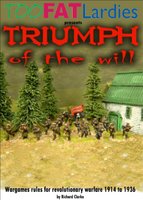 Triumph of the Will (TotW) is a set of miniature wargames rules for “revolutionary warfare” in the period 1914 to 1936 by Richard Clarke of the Too Fat Lardies. The rules are designed for brigade or divisional level actions with the smallest manoeuvre unit being the Company and with the basic command unit being a Battalion. Typically a Company will be represented by 6-10 figures; however, the rules utilise the number of figures in a unit to represent the motivation/resolve of the unit rather than the actual size and thus there is no figure ratio.
Triumph of the Will (TotW) is a set of miniature wargames rules for “revolutionary warfare” in the period 1914 to 1936 by Richard Clarke of the Too Fat Lardies. The rules are designed for brigade or divisional level actions with the smallest manoeuvre unit being the Company and with the basic command unit being a Battalion. Typically a Company will be represented by 6-10 figures; however, the rules utilise the number of figures in a unit to represent the motivation/resolve of the unit rather than the actual size and thus there is no figure ratio. Presentation
TotW is available in both hard copy and Adobe .pdf download forms. The rules are clearly layed out in sections with a table of contents and some examples. There are no graphics and, other than the front cover, the rules are in black and white. This obviously has benefits if your are buying the .pdf option and printing it yourself. A few more examples would certainly be beneficial but overall the presentation is good.
Turn Sequence
The turn structure is as follows:
- Spotting
- Cavalry/infantry/MG fire
- All movement
- Artillery & AFV fire/Air attacks
- Close combat
- Command Actions
Two options are provided for turn sequence a traditional I go you go system (albeit with a reserved fire mechanism) or a card driven system (but with all cards being drawn each turn).
Spotting
A system of blinds is utilised to enable hidden unit movement. Spotting is effected by selecting the relevant blind and rolling on a table with modifications for range, terrain types and weather.
Firing
All firing in TotW is based on a rifle unit equivalency system with a unit of five infantry figures being the basic standard. A d6 is rolled for each unit of 5 figures or equivalent with modifiers for troop quality, situation, cover etc. and if the result is less than the firing group’s strength then a hit is achieved. Fire may be reserved to be used in the opponent’s turn.
Firing at extreme range does not cause casualties but rather reduces the unit’s movement in the following turn.
Movement
The deployment of the (rectangular) blinds indicates the unit formation (e.g. column, line) and this determines the distance the blind may move. Once spotted, infantry units move their unit strength in inches with vehicles moving on dAv rolls.
AFV Combat
Given the limited development of the AFV during this period the AFV combat rules are simple with weapons categorised into MG/light/medium/heavy and armour into heavy or light. AFVs have strength ratings which are lost as they suffer hits and this is also factored into their firing capability.
Close Combat
Close combat is a pretty brutal affair with units rolling a d6 per figure with the number of dice being modified for unit type, status and the like. This is then resolved on a “six and you’re dead” basis with the casualty levels inflicted being compared and the overall combat result being derived from a table.
The use of a six in this instance is a little inconsistent as elsewhere in the game a low roll is good – we have a house rule where we use a 1 rather than a 6 to avoid this.
Command Actions
Units are given one of 5 orders – Attack/Engage/Hold/Retire/Consolidate. The quality of the CinC determines the number of order changes which they can instruct in any turn (although units can attempt to change their own orders by rolling against their initiative rating which will depend on the period and unit type); however, the type of commander affects which orders he may issue. For example an aggressive commander will find it more difficult to issue Retire orders than Attack orders.
Period Specific Rules / Information
Period specific notes are provided for Revolutionary Germany, the Spanish Civil War and the Russian Civil War (RCW). These include supporting information for the relevant forces and additional rules for specific tactics and equipment. For example there is a whole section on armoured trains for the RCW.
TotW also provides appropriate guidance on the use of battlefield features such as trenches, wire and the like.
Summary
Having used these rules for both Russian Civil War and Spanish Civil War scenarios I have found they give a good quick game with plenty of period flavour. The period specific elements help greatly here and whilst the basic mechanisms remain unchanged they add a lot to the feel of the game.
These rules aren’t as well developed or supported as I Ain’t Been Shot, Mum the Lardies main offering, and consequently questions will arise during play. However, the Lardies’ Yahoo discussion group is a good source of information and the author is will usually respond to questions quickly.
No comments:
Post a Comment